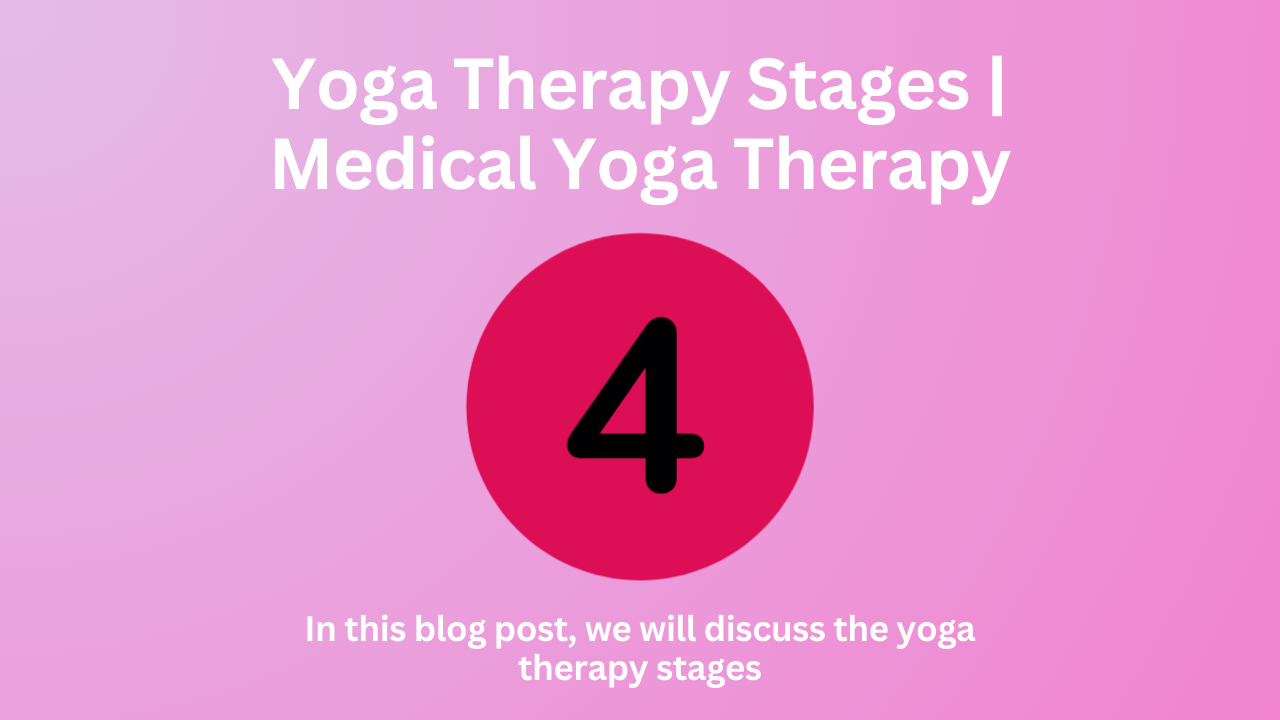Yoga Therapy Stages | Medical Yoga Therapy

In this post of blog, we will discuss the yoga therapy stages. The Vedic phases of life for contemporary times via the prism of yoga philosophy, along with advice on how to live a more contented life overall. It provides a fun glimpse into how modern yogis are prospering through different phases, ranging from relationships and schooling to monasticism.
Created by the rishis of Vedic India from the upper eras, these are the four “ashrams” of life that are considered fundamental. These are the following age groups: Student Stage (ages 0–24), Householder (ages 24-48), Forest Dweller (ages 48–72), and Sannyasin (ages 72-120). The great yogis and rishis created these phases to help heal social issues and provide a meaningful framework for living that would increase pleasure and peace on Earth.
Four Stages of Yoga Practice
Concepts on the possible structure of a yoga practice over the four phases. Remember that each person’s experience is distinct and difficult to categorize.
Brahmacharya – Level of Students
- An unmarried student practices with fervor and excitement has free time, is not burdened by material obligations, and devotes most of their energy to sadhana, dedication, seeking their vision, and achieving their aspirations.
- Every aspect of life is centered on learning, practicing yoga every day, and creating a yoga study; relationships, employment, and housing are all related to and supportive of yoga practice.
- Strictly follows Ashtanga tradition with unquestioned commitment, practices vigorously and religiously 6 days per week, faithfully following series, performing every pose in sequence, totally devoted and fully relishing in participating in the effort to develop self via improving practice.
- Study of different schools of yoga, including bhakti, holy writings, and a willingness to attempt ascetic exercises like brahmacharya, tapas, chanting, and prayer.
- Psychic environment where practice, self-improvement, aiming high, dreaming, visioning, incubation, and being a member of a community of lineage-following students are all taking place.
Grhasta: Stage of Householders
- Practice comes second to worldly obligations; it supports family, children, employment, and other commitments.
- Inventive in using time management to maximize the value of shorter practices.
- Thinking in terms of categories of asanas, such as standing poses, sitting forward bends, standing twists, seated twists, and inversions, and then varying practice by portraying the various categories.
- Voiding the rigid sequence of series.
- For instance, choose one or more of the standing poses from this category each day rather than doing the whole sequence of postures, and repeat the process with the sitting postures.
- Make decisions based on choosing a target area or on how to depict each category.
- You may change up your approach and are adaptable.
- You are considering how to use the strategies you acquired throughout the student period with flexibility and creativity.
- Trying my hardest to maintain a strong, productive yoga practice while adjusting the practice to life rather than the other way around.
- Rejecting the idea of all or nothing; instead, embrace compromise and cultivate the skill of giving your all, even if it means settling for less-than-ideal standards.
- Gain knowledge by allowing the distinctions between practice and worldly life to dissolve to some extent—seeing that such divisions are ultimately artificial and inflexible thinking and intolerance are enemies that damage your capacity to do yoga.
- Flexible, tolerant, accepting, content with little, letting go of rigidity, softening, enabling the delights of connection and relationship to blend freely with the joys of asceticism, tapas, and isolation.
- Thinking of your job as completing your dharma—sacred duty—and consequently part of your yoga practice—is not something that keeps you away from practice.
- Make use of your aptitude for using hatha yoga technology to guide, assist, and enhance the job you do in the world.
- Devoting yourself to doing your share to change the world for the better.
Vanaprastha–Forest Dweller Stage
- Withdrawal, physical and mental isolation, and loneliness.
- Taking advantage of your independence to spend time with yourself and enjoy your own company.
- Pay less attention to what other people think and more attention to what is going on inside of you. Have faith in yourself, get to know, value, cherish, and take care of yourself.
- If you want to practice, individualize it, pay attention to what your body is telling you, and go with your gut rather than attempting to adhere to rigid rules set by others, instructors, or tradition.
- Because you are aware of the daily sadhana’s genuine, infinite significance, take your practice more seriously. Permitting oneself to delve inside will allow you to go far deeper than previously.
- Have complete confidence in your capacity to advance both your yoga practice and your knowledge of the discipline by pursuing the aspects of hatha yoga technology that pique your interest.
- Go more slowly, hold postures longer, and do fewer poses with more integrity and awareness.
- Take a greater interest in Raja vs. Hatha yoga– meditation vs all the energetic methods of asana, pranayama, bandhas, and vinyasa.
- Value inversions improve your awareness, respect, and proficiency in Head Balance and Shoulderstand.
- During your asana practice, pay greater attention to all aspects of breathing and practice pranayama more. Spend as much time mastering the pranayama methods as you did your asanas. These include viloma, bhastrika, nadi shodana, external and internal kumbhakas, and ujjayi.
- Allow the realization that practicing the finest, most fundamental hatha methods consistently throughout the day will keep you near the state of yoga day and night to seep into your bones and viscera.
Sannayasin: Discernment Stage
- Practice only for enjoyment.
- Your life and your practice merge into one entity.
- Practice as an act of pure dedication, devoid of ambition, self-interest, or any thoughts of financial gain.
- Gratitude and humor.
- Capable of being both pragmatic and sensitive to the nuances of the methods. For instance, breathing with grace and expertise not only promotes physical well-being but also facilitates communication with the divine realm of the universe.
- Practice to ward against death while also acknowledging that this phase of the cycle is normal. Sometimes, with continued awareness, fear dissolves on its own.
- Appreciating quiet, stillness, nothingness, and being.
Value of Each Step
The Four Stages of Yoga relate, from a flat, one-dimensional perspective, to the chronological age of our bodies as they move through this earthly plane. There is a strong focus on youth in the West (and across much of the world)—looking youthful and holding onto your youth for as long as possible. The rishis devised The Four Stages of Yoga as a framework for experiencing life more thoroughly, in a multi-dimensional manner. In our quest for Self-realization, we concentrate on certain teachings at each level.
- For example, during the First Stage of Yoga, also known as the Student Stage, students should ideally acquire fundamental skills including how to take care of their bodies, how to comprehend others, how to meditate, and how to listen to parents and instructors who have also gone through the First Stage of Yoga.
- One starts to develop in several ways during the Second Stage of Yoga; one could discover a job, exciting new experiences, marriage, or a group of like-minded people. Without a deeper comprehension of yoga teachings, many people may never make it out of the second stage of yoga, known as the householder stage. It is a very fascinating period. Every one of the four phases has a distinct emphasis. The goal of the yogi is to comprehend their soul’s dharma, or mission, in each of the four phases.
- The Forest-Dweller Stage, also known as the Third Stage of Yoga, is a crucial life transition stage. At this point, we may create a new existence by using introspection. After completing the householder stage, the Forest Dweller gathers all of their talents from 48 years of existence and starts to build their special contribution, much like the phoenix rising from the ashes. To pull back from the fast-paced existence of the previous two phases while speeding ahead in novel and inventive ways is what the third stage demands.
- One joins The Sannyasi Stage of Yoga at the age of 72. This may be the most influential period of your life. At the Sannyasi Stage, all of one’s attention is on living entirely for Spirit. Sannyasis still has to work and live in the world. The “wise elders” are Sannyasis and elderly Forest Dwellers, whose knowledge is required by people in the first two levels of yoga. Our culture needs knowledgeable seniors, not those who brush them off or send them “out to pasture.” It’s been said that “how we treat others, that’s how we will be treated.”
Obstacles
- Every step of yoga has a different difficulty since we are all different.
- The Householder Stage might be difficult for certain souls to comprehend or get along with others, but it can also be simple and full of love for others for other souls.
- Life is a multifaceted experience that teaches every soul a lesson.
- At each of these crucial phases, layers of knowledge offer fresh perspectives, much as when peeling an onion.
Conclusion
Yoga philosophy provides a framework for living a contented life through four stages: Student Stage (ages 0-24), Householder (ages 24-48), Forest Dweller (ages 48-72), and Sannyasin (ages 72-120). Each stage has unique experiences, such as dedication, isolation, and enjoyment. The four stages of yoga focus on personal development, balance, courage, and living for Spirit, to understand one’s soul’s dharma and achieve self-realization.



0 Comments